|
|
|
Sort Order |
|
|
|
Items / Page
|
|
|
|
|
|
|
| Srl | Item |
| 1 |
ID:
188038
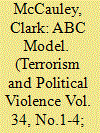

|
|
|
|
|
| Summary/Abstract |
In this commentary, I compare the ABC model of radicalization with the Two Pyramids model of radicalization. Both models distinguish radicalization of opinion from radicalization of action. Beyond this agreement are questions about the concepts deployed in advancing the ABC model and research issues relating to applications of the two models. I conclude with an optimistic assessment of recent progress in research on terrorism, including the suggestion that deradicalization of action may be forwarded by giving up on deradicalization of opinion.
|
|
|
|
|
|
|
|
|
|
|
|
|
|
|
|
| 2 |
ID:
188037
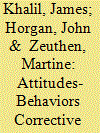

|
|
|
|
|
| Summary/Abstract |
Progress in understanding and responding to terrorism and violent extremism has continued to stall in part because we often fail to adequately conceptualize the problem. Perhaps most notably, much of our terminology (for instance, “radicalization”) and many variants of our existing models and analogies (including conveyor belts, staircases and pyramids) conflate sympathy for this violence with involvement in its creation. As its name suggests, the Attitudes-Behaviors Corrective (ABC) model seeks to overcome this issue by placing this key disconnect between attitudes and behaviors at its core. In this paper, we first present the key elements of our model, which include a graphic representation of this disconnect and a classification system of the drivers of violent extremism. The former enables us to track the trajectories of individuals in relation to both their attitudes and behaviors, while the latter helps ensure that we consider all potential explanations for these movements. We then adapt these elements to focus on exit from violence, applying the dual concepts of disengagement and deradicalization. Finally, we conclude with a section that aims to provide the research community and those tasked with preventing and countering violent extremism with practical benefits from the ABC model.
|
|
|
|
|
|
|
|
|
|
|
|
|
|
|
|
| 3 |
ID:
188760
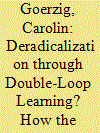

|
|
|
|
|
| Summary/Abstract |
The transformation of the Gamaa Islamiya can be understood by analyzing it against Argyris and Schön’s double-loop learning model. This paper bases the analysis on five books published by the Gamaa Islamiya, which include comprehensive elaborations on internal reflections and criticism of Al-Qaeda. While the Gamaa Islamiya’s learning can be framed with the model of double-loop learning, Al-Qaeda’s reactions can be depicted as a less evolved single-loop learning system. This case is relevant for the discovery of key mechanisms of de-radicalization that could be used as a blueprint for other groups.
|
|
|
|
|
|
|
|
|
|
|
|
|
|
|
|
| 4 |
ID:
172058
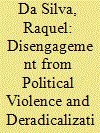

|
|
|
|
|
| Summary/Abstract |
This article applies a dialogical analysis to the change processes involved in moving from engagement with to disengagement from an armed militant group, as well as from radicalization to deradicalization. The findings underline the interplay between different push and pull factors at individual, organizational, and societal levels that played a role in the already mentioned processes in three periods of time—engagement with, life within, and disengagement from an armed organization. The dialogical framework conceptualizes the development trajectory as relationships between a variety of positions of the self (I-positions), which generate different personal meanings involved in processes of disengagement and deradicalization.
|
|
|
|
|
|
|
|
|
|
|
|
|
|
|
|
| 5 |
ID:
109143
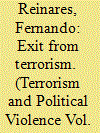

|
|
|
|
|
| Publication |
2011.
|
| Summary/Abstract |
Terrorists disengage from the groups or organizations to which they belong as a result of structural, organizational, or personal factors. These types of factors seem to operate with relative mutual independence. All this can be analytically induced from research conducted at an individual level of analysis, based on 35 long interviews with former members of ETA who voluntarily decided to conclude their militancy at some point between 1970 and 2000. Until the mid-1980s, the individual decision to leave ETA tended to be linked to a subjective perception of ongoing political and social changes. From then on, disagreement with the internal functioning of the ethno-nationalist terrorist organization or the tactics adopted by its leaders became more salient motivations for those militants who decided to walk away. All along, however, there were ETA members who left terrorism behind for reasons of a rather personal nature. As expected, in this qualitative empirical study, disengagement was found to be a process seldom concomitant to that of deradicalization.
|
|
|
|
|
|
|
|
|
|
|
|
|
|
|
|
| 6 |
ID:
160520
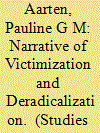

|
|
|
|
|
| Summary/Abstract |
While the study of victimology and radicalization mainly focuses on those who suffered from terrorist attacks, this article explores the role of victimological processes in deradicalization. Experts from different international deradicalization initiatives were interviewed. Using the narrative framework with its three key concepts—identity, emotion, and culture—as set forth by Pemberton and Aarten in this issue, the relationship between victimization and deradicalization is more thoroughly examined. Key findings include the delicacy of the term “victim” in radicals' narrative identity, the power of narrative in triggering and transmitting emotions, and the importance of a former radical that acknowledges the narratives of the radical and offers alternative narratives to their radicalized ideologies.
|
|
|
|
|
|
|
|
|
|
|
|
|
|
|
|
| 7 |
ID:
134156


|
|
|
|
|
| Publication |
2014.
|
| Summary/Abstract |
Although research on violent extremism traditionally focuses on why individuals become involved in terrorism, recent efforts have started to tackle the question of why individuals leave terrorist groups. Research on terrorist disengagement, however, remains conceptually and theoretically underdeveloped. In an effort to enhance our understanding of disengagement from terrorism and pave the way for future empirical work, this article provides a multidisciplinary review of related research from psychology, sociology, and criminology. Significant promise for moving beyond the existing push/pull framework is found in Rusbult and colleagues' investment model from psychology and Ebaugh's research on voluntary role exit from sociology. Rusbult's investment model offers insight into when and why individuals disengage from terrorism, while accounting for individual, group, and macro-level differences in the satisfaction one derives from involvement, the investments incurred, and the alternatives available. Ebaugh's research on voluntary role exit provides a deeper understanding of how people leave, including the emotions and cuing behavior likely to be involved. The article highlights the strengths and limitations of these frameworks in explaining exit and exit processes across a variety of social roles, including potentially the terrorist role, and lends additional insights into terrorist disengagement through a review of related research on desistance from crime, disaffiliation from new religious movements, and turnover in traditional work organizations.
|
|
|
|
|
|
|
|
|
|
|
|
|
|
|
|
|
|
|
|
|